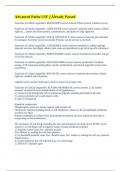Exam (elaborations)
Advanced Patho USF || Already Passed.
- Module
- Institution
Functions of cellular organelles: RIBOSOMES correct answers Where protein synthesis occurs Functions of cellular organelles : SMOOTH ER correct answers communication system, cellular highway.....makes and sends protein, carbohydrates, and lipids to Golgi apparatus Functions of cellular organe...
[Show more]



